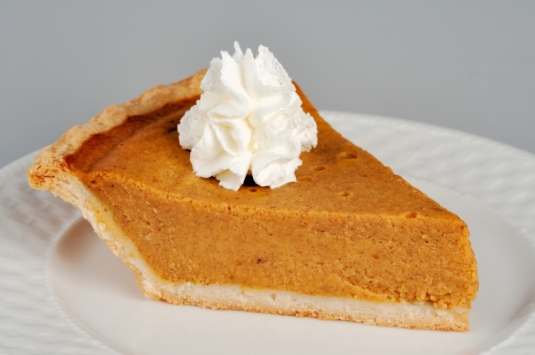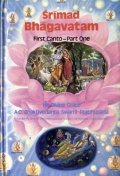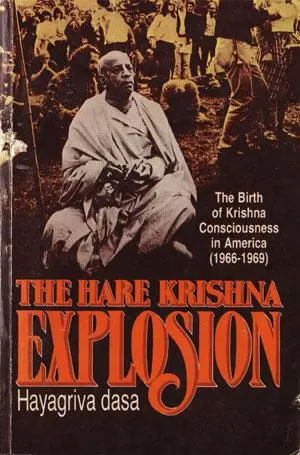26 Jul 2023
by The Hare Krishna Movement
in Vegetarian Cooking, Vegetarian Recipies
Tags: gardening, vegetarian banana bread, vegetarian cooking, zucchini bread
I don’t know if any you have planted a garden this year, but mine is doing very nicely, with tomatoes, okra, Swiss chard, and zucchini all coming into full production. The Zucchini has done particularly well this year, and I have an over abundance. I have tried freezing some (with good success) but then I saw some very ripe Bananas on the counter and it hit me to make some Banana/Zucchini bread loaves. I found that a loaf would keep very well without refrigeration for week, and also the loafs freeze very well.
Basic Recipe
More
11 Jun 2023
by The Hare Krishna Movement
in Mint Chutney, Vegetarian Cooking, Vegetarian Recipies
Tags: aids in digestion, Ancient times, Ayurvedic, detoxifying, doshas, Mint Chutney, pudina chutney, tridoshic
We have an abundance of fresh mint leaves just growing wild, outside our back door, here in West Virginia. And this morning I decided to try my hand at making some Mint Chutney. I went through a few of my favorite Indian cookbooks, and looked at a few recipes online. It seems like there are hundreds of variations to this basic recipe. But I chose one that I had all the ingredients to make, and we share it with you today.
If you plan on making a large batch (which I plan to do), the freezer is your friend. Otherwise if will keep fresh for a couple of days in the fridge.
Mint is a herb that has been used in Ayurvedic practices since Ancient Times. It is a healing herb that has some nutritional values and health benefits, especially when eaten fresh without cooking.
Mint leaves are said to be Tridoshic, meaning have the potential to balance all kinds of imbalances (doshas) in the body. They are calming, refreshing, detoxifying, and aids in digestion.
Use fresh green leaves that are vibrant in color, and avoid using the stalks and stems, as they can impart a bitter taste.
Adding a few teaspoons of lemon juice helps preserve the bright green color.
Recipe
More
01 Jan 2023
by The Hare Krishna Movement
in A. C. Bhaktivedanta Swami Prabhupada, Krishna Consciousness, Kurma das (cook), Spiritual Practice, Vegetarian Cooking, Vegetarian Recipies, Vegetarianism
Tags: Apurva das, cooking for Krishna, Feast, Gopati das, Krishna, Kurma das, Srila Prabhupada, veteran ISKCON cooks
My wife shared this with me, something she saw on Facebook. Time Tested “Big” Prasadam Recipies. Love Kurma’s cookbooks and recipes. Hare Krishna and happy New Year!
New Kurma Cookbook!
I’ve finally opened my treasure trove of time-tested ‘big’ prasadam recipes from five decades of quantity cooking. Interwoven with hundreds of fascinating stories, realizations and memories from early disciples, FEAST includes Srila Prabhupada’s original recipes, ISKCON Sunday feast kitchen classics, and modern favourites.
This large and beautifully presented 492-page book, designed and published by Srimati Mayapriya devi dasi from Bookwrights Press, is a generous collection of 375 meticulous, large-sized vegetarian and plant-based recipes from myself and veteran chefs Gopati dasa and Apurva dasa, as well as 60 other Hare Krishna kitchen giants.
Feast is a legacy of love, offered by ISKCON’s first generation of cooks for future chefs, and for the upliftment of human society at large. Srila Prabhupada writes “Simply by liberal distribution of prasada and sankirtana, the whole world can become peaceful and prosperous.” (SB 4.12.10)
Coming soon!
13 Feb 2022
by The Hare Krishna Movement
in sweet rice, Vegetarian Recipies
Tags: Prasadam, sweet rice, vegetarian cooking, vegetarian recipes
With the advent of Lord Nityananda’s appearance day coming up on on Monday February 14th, I am already planing the feast we will offer. One of my personal favorite preparations that is usually offered on festival days is sweet rice. It should be chilled before offering so I have decided to cook it today (Sunday) so it can chill in refrigerator overnight. The following recipe is from the original The Hare Krishna Cookbook.
Sweet Rice III
1/4 cup white or Basmati rice
3/4 cup sugar
1/2 gallon milk
15 whole cardamom pods (opt.)
Cook all the rice with one cup of milk for about 20 minutes until soft. Then add the cardamom pods. Gradually, add the remaining amount of milk, stirring occasionally with a wooden spoon over the next hour or two over low heat. Before you remove the sweet rice from heat, add the sugar and stir untill the sugar is completely absorbed. (if cardamom pods were used, remove them before sweet rice cools) Place sweet rice in refrigerator and offer when very cold.
Note: Do not cook sweet rice in an aluminum pot.
25 Nov 2021
by The Hare Krishna Movement
in eggless pumpkin pie, Vegetarian Cooking, Vegetarian Recipies
Tags: eggless pumpkin pie, thanksgiving recipe, vegetarian cooking, vegetarian recipes
Today in the West people are celebrating “Thanksgiving”. So we are posting a traditional Thanksgiving recipe; Pumpkin Pie (without the eggs). I have been making egg-less pies for the last 39 years, and have tried many different variations. I use 2 tablespoons of sour cream instead of 2 eggs, and one year I used Philadelphia cream cheese instead of evaporated milk, all with good success.
If you want to do everything yourself, there is the do it yourself recipe for a “homemade” pie crust, pumpkin puree, spicing, and sweetened whipped cream.
Ingredients:
More
25 Aug 2020
by The Hare Krishna Movement
in Kachori, Radhaballabha Kachoris, Radhastami, Srimati Radharani, The Hare Krsna Cookbook, Vegetarian Cooking, Vegetarian Recipies
Tags: appearance day of srimati radharani, hare krishna cookbook, Krishna, Radha, radhallabha kachoris recipe, Srimate Radharani, vegetarian cooking

Today we celebrate the Appearance Day of Srimati Radharani [Radhastami] with a half day fast followed by a feast cooked in honor of Srimati Radharani. She appears at noon so we begin our day with songs in praise of Srimati Radharani and time in the kitchen cooking up a nice vegetarian offering. Since She is fond of Kachori’s, we share with you this nice recipe from “The Hare Krishna Cookbok”; Radhaballabha Kachoris.
“This preparation is one of Srimati Radharani’s favorites and is always prepared for Her appearance day. There is nothing in the material world to compare with the flavor of Radhaballabha Kachoris”.
Radhaballabha Kachoris Recipe
ghee for deep frying
1 cup of cleaned, split urad dhal
2 cups white flour
cayenne pepper
asafoetida
2 T. freshly ground anise seed
butter or ghee solids
Wash urad dahl thoroughly. Soak in water overnight. Drain, leaving a tiny bit of water. In a blender, grind urad dhal untill it is a smooth paste, adding a little more water if necessary. The past should ve very thick. Set aside. Add ground anise seed to paste. Using white flour, butter or ghee solids and water, make a soft dough, like puri dough. (not wet.) Let the dough sit for one hour under a dampened cloth. Meanwhile prepare three very small bowls in the following manner:
1. Put in a mixture of 1 T. water and 1/2 t. asafoetida.
2. Put plain salt in the second.
3. Put cayenne pepper in the third.
Pinch off balls of dough one inch in diameter. Roll them out into circles of 2 1/2 inches in diameter. Pinch off a ball of kachori paste about one inch in diameter; dip into each of bowls in succession, and place in the center of the circle of kachori dough. Gather up the dough around the paste as you would gather a paper bag. Make sure all the urad dahl paste is covered, and seal the top edge very well using a little water. Flatten the sealed kachori with a rolling pin and then roll gently as you would apuri or chapati.
Be carful not to break the surfaces. If necessary, pat them out by hand. Deep-fry the kachori in fairly hot ghee as you would a puri. Stand up kachoris on paper toweling to drain. Before offering them, re-fry very quickly, but do not brown.
“This preparation is one of Srimati Radharani’s favorites and is always prepared for Her appearance day. There is nothing in the material world to compare with the flavor of Radhaballabha Kachoris”.
This recipe I copied from; “The Hare Krishna Cookbook” [click on link to down load the entire book]
18 Jul 2020
by The Hare Krishna Movement
in Albert Einstein, People, Vegetarian Cooking, Vegetarian Recipies, Vegetarianism
Tags: basic vegetarian recipes, Hare Krishna, hare krishna cookbook, Prasadam, the Hare Krishna cookbook, vegan, vegetarian cooking, vegetarianism

Nothing will benefit human health and increase chances for the survival of life on Earth as much as the evolution to a vegetarian diet. -Albert Einstein
I personally feel it is very important to eat as healthy as possible. That is one of the reasons I plant a garden. Although not everyone has that luxury to plant a garden, still there are so many fresh fruits and vegetables available in every American grocery store, there is ample opportunity to eat a healthy vegetarian diet.
Back in 1972 when I first became a vegetarian, the challenge was learning how to cook vegetarian meals. Therefore I am including the first cookbook that taught me the basics as a free pdf download (just click on link at bottom of post). Wishing you all a happy and healthy life. -V
More
14 Apr 2020
by The Hare Krishna Movement
in chapati, Vegetarian Recipies, Vegetarianism
Tags: basic vegetarian recipes, cooking for Krishna, vegerarian cooking, vegetarian recipes, vegetarianism

With all this extra time at home, I have been spending more time in the kitchen. Instead of the quick meal that often took place after a long days work, we are finding renewed pleasure in going through our vegetarian cookbooks and planning nice well balanced meals. One thing we have been eating more of is chapatis. They go well with almost every vegetable dish, are easy to prepare, and are a healthy alternative to bread which usually contains yeast.
From The Hare KRSNA Cookbook 1972
Basic Chapati
1 cup Whole Weat Flour
1/4 cup Melted Butter
Warm water
Mix the flour and water together, adding water gradually until dough is soft but not wet, and can be kneaded. Knead the dough until it’s fairly soft (8 to 10 minutes). Cover and let dough rest for one hour. Sprinkle flour on rolling area and makes 1-1/2 inch balls out of dough. Flatten balls and roll out to about 4-5″ diameter. Place the chapati on a heated skillet (dry, free from oil) and cook until bubbles appear. Turn chapati quickly and let cook until bubbles appear again. Using tongs, remove chapati from pan, and hold over an open flame or burner to make it puff up. Heat it first on the side that was first cooked. You can lay directly on the burner for a brief moment, but don’t let it stick. When chapati puffs up, turn quickly and repeat on other side till it puffs. Remove, butter both sides, and cover with a clean cloth to keep in heat while remaining chapatis are cooked.
01 Jan 2018
by The Hare Krishna Movement
in Gulub Jamun, Kurma das (cook), Vegetarian Cooking, Vegetarian Recipies, Vegetarianism
Tags: cooking with Kurma, gulub jamun recipe, hare krishna cooking, Kurma das, milk balls, vegan, vegetarian, vegetarian cooking, vegetarian cuisine

Today being the New Year, a Holiday celebrated around the world, we thought we would post a festive recipe. This Gulab Jumaun recipe was taken from the very nice cooking web page Cooking with Kurma. I encourage you all to try this wonderful recipe on your friends and family.
Succulent Milk Balls in Rose-scented Syrup (Gulab Jamuns)
Gulab Jamuns are ideal confections for festive moments and entertaining. When guests are confronted with them for the first time they invariably ask, “What are they? ” Guesses then range from preserved fruits to doughnuts. In fact, Gulab Jamuns are made from just milk powder and flour. They’re fried slowly in ghee until the lactose in the milk powder caramelises and turns them a golden brown, and then they are soaked in a rose-scented, medium- heavy sugar syrup. Hence, the Hindi words Gulab Jamun meaning literally “rose ball”.
Full recipe follows More
24 Nov 2016
by The Hare Krishna Movement
in Vegetarian Cooking, Vegetarian Recipies, Vegetarianism
Tags: cooking without eggs, eggless cooking, eggless tapioca pudding, Ekadashi, Tapioca Pudding, thanksgiving, vegetarian cooking, vegetarian recipes

This morning I was thinking what to cook for a Thanksgiving Offering. There was some confusion on the two calendars we have, because one said that today was Ekadashi (fasting day from grains and beans) and the other gave an alternate date of tomorrow for our location. But I decided to play it safe and observe Ekadashi with my menu planning. I decided it would be good to make a nice Tapioca Pudding (without eggs).
The beauty of this tapioca pudding is that it is egg-less and it does not need baking. It is cooked right on stove top with just three main ingredients: tapioca, milk and sugar. Just like that it tastes good but often it is further embellished with cashews, saffron and cardamom. Or you can use seasonal fruits to garnish.
Eggless Tapioca Pudding
1/2 cup tapioca
1/2 cup sugar
4 cups milk
1 teaspoon pure vanilla extract
DIRECTIONS
* Combine tapioca, milk & sugar in a medium/large saucepan and let sit for 5 minutes.
* Bring to a slow boil over medium high heat. Stir the milk and tapioca and sugar frequently to prevent it from sticking to the bottom of the container. It thickens as it cooks but will still be a liquid.
* Remove from heat and add vanilla.
* Cardamom (optional), Saffron (optional), and Cashews (optional)
* Stir & allow to cool. It thickens as it cools.
Makes 8-10 servings
Note: Two tablespoons of tapioca for a cup of milk will give you a fairly thick pudding. If you want yours thin, use less tapioca or more milk. Same goes for sugar.
08 Oct 2016
by The Hare Krishna Movement
in Ghee, Vegetarian Cooking, Vegetarian Recipies, Vegetarianism
Tags: cooking oil, cooking with ghee, crown jewel of oils, foodstuff, fried in ghee, ghee, golden ghee, Krsna prasadam, Prasadam, Srimati Radharane, vegetarian cooking

Previously we posted part One & Two of the article on Ghee (which is the crown jewel of oils, and is one of Srimati Radharani’s most favored ingredients). Today we are posting part Three of this fine article as posted on the Sampradaya Sun
Prasadam – Ghee, Part Three
by Sun Staff (SUN)
A journey through India: border to border, bhoga to prasadam.
The importance of golden ghee in cooking Krsna prasadam is very evident when we consider books of Vaisnava literature such as Sri Govinda-lilamrta and Sri Caitanya-caritamrta. In Govinda-lilamrta we find descriptions of the great range of uses for ghee, as it’s described in the conversations between Mother Yasoda and the gopis who are arranging so many nice foodstuffs for Krsna.
In Verse 53, Mother Yasoda is telling Kilimba that they had milked the cow named Sugandha, and churned her milk into butter, and the gopis could use this special butter to make ghee. Yashoda requests the gopis to make many different dishes cooked in ghee, and to prepare sweets with ghee, and Rohini Devi also describes the preparations Radharani has been making for Krsna with ghee.
More
05 Oct 2016
by The Hare Krishna Movement
in Ghee, Prasadam, Rochan das, Vegetarian Cooking, Vegetarian Recipies, Vegetarianism
Tags: cow protection, deep fried in ghee, ghee, Mahamrtunjaya Mantra, making ghee, Prasadam, Vedic tradition, vegetarian cooking, Worship Krsna by offering ghee lamps

This morning I happened to visit the Sampradaya Sun web page. Rocan Prabhu has been doing a series entitled ” A journey through India: border to border, bhoga to prasadam” and in the last week has done a two part article on ‘Ghee’. We have reprinted both the first and second part here.
Prasadam – Ghee
by Sun Staff
…the Mother of all ingredients is milk, and all its glorious byproducts. Today we’ll begin an exploration of ghee, which is one of the final foodstuffs derived from processing milk. Cow’s milk is said to possess the essential sap of all plants, and ghee is a most valued derivation of that nutritious stuff. The clear golden liquid known as ghee is the crown jewel of oils, and is one of Srimati Radharani’s most favored ingredients.
The word ghee comes from the Sanskrit ghrta [ghrit], or “sprinkled”. Aayurghritam means ‘ghee is life’, and this is reflected in the many sacred ways the stuff is used in devotional practice, from cooking to feeding the sacred fire, or performing abhisheka with panchamrta. Use of ghee as a substance to anoint the Deities is mentioned in Yajurveda, and the Rgveda has many references to butter and ghee.
More
14 Dec 2014
by The Hare Krishna Movement
in Kachori, Vegetarian Cooking, Vegetarianism
Tags: deep fried in ghee, flaky dough, ghee, kachoris, pastry with filling, poori, puris, sunday feast, vegetarian, vegetarian cookbook, vegetarian cooking, vegetarian recipes
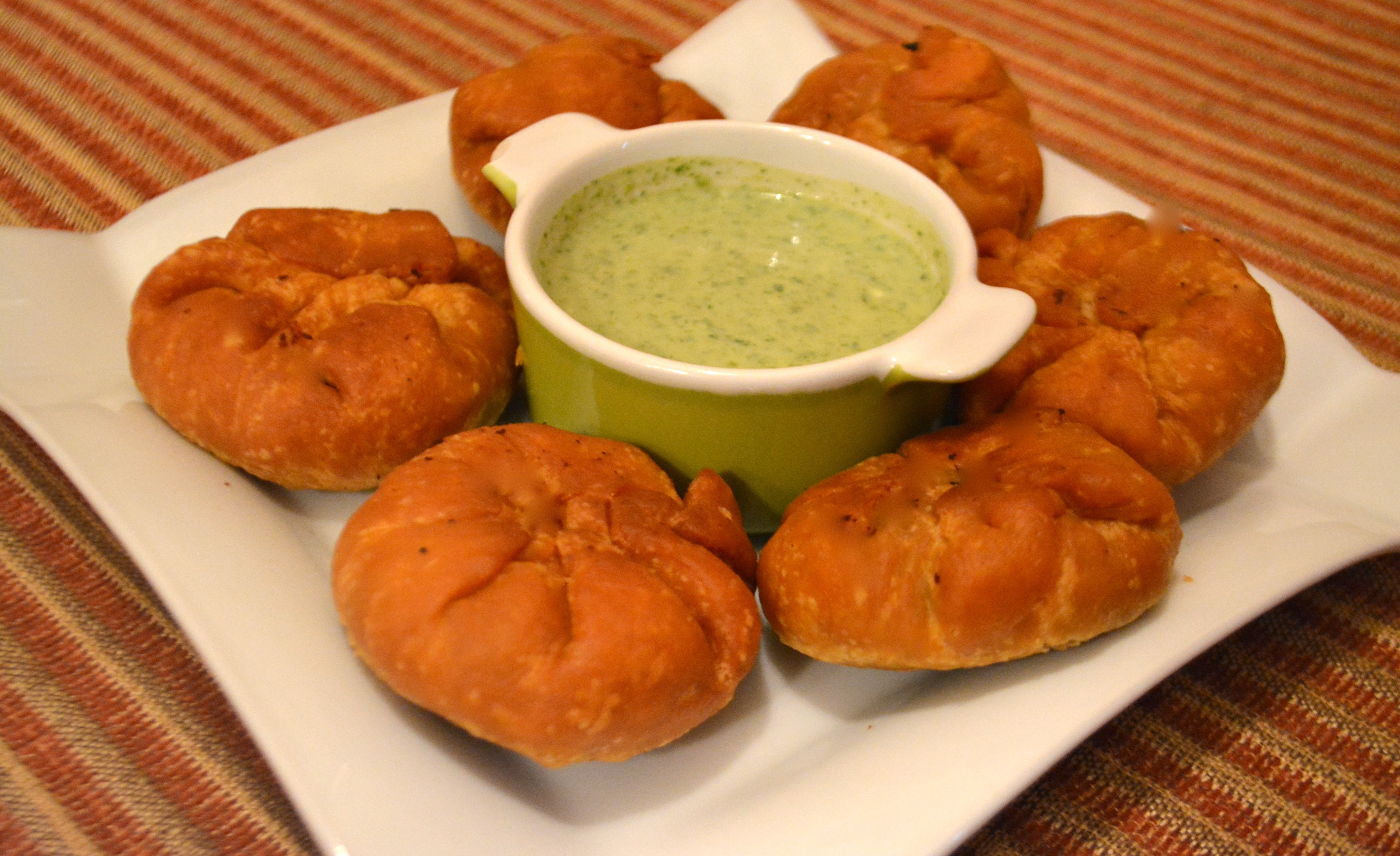
Kachoris Recipes
Today being Sunday, and with the weather cold and wet, I decided to stay indoors and practice my cooking, by learning how to cook Kachoris, which is basically a pastry with filling, for the Lord. I have never actually made them before, although I have eaten countless kachoris at various feasts. So I searched for some recipes in our cookbooks and on the Internet and found a nice selection of recipes for different types of Kachoris at harekrsna.com. So I have posted many nice Kachori recipes or variations, and will pick one to cook today for our Sunday Feast.
More
27 Nov 2014
by The Hare Krishna Movement
in Vegetarian Cooking, Vegetarian Recipies
Tags: egg-less cooking, eggless sweet potato pie, homemade pie crust, sweet potato pie, sweet potato puree, thanksgiving, thanksgiving recipe, vegetarian recipies, vegetarian sweet potato pie
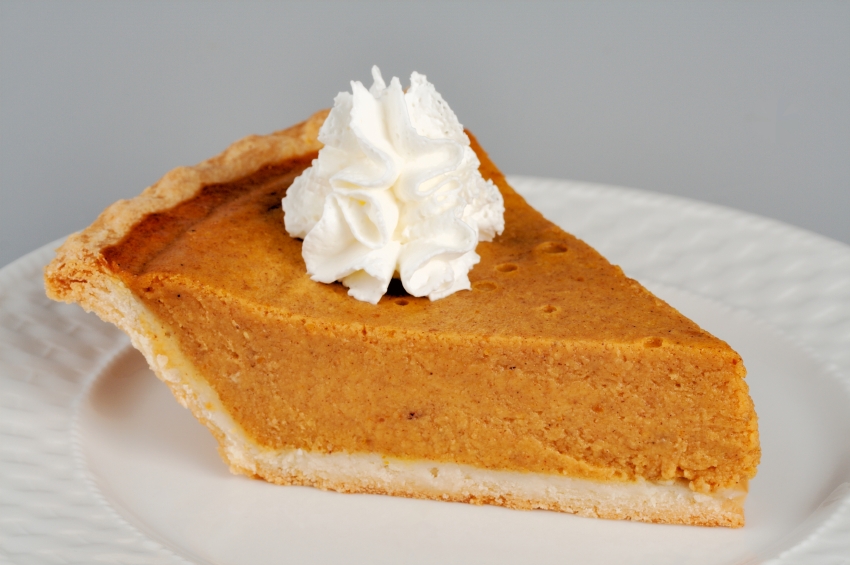
Today in the West people are celebrating “Thanksgiving”. So we are posting a traditional Thanksgiving recipe; Sweet Potato Pie (without the eggs). I have been making egg-less pies for the last 39 years, and have tried many different variations. I use 2 tablespoons of sour cream instead of 2 eggs, and one year I used Philadelphia cream cheese instead of evaporated milk, all with good success.
If you want to do everything yourself, there is the do it yourself recipe for a “homemade” pie crust, sweet potato puree, spicing, and sweetened whipped cream.
More
24 Nov 2014
by The Hare Krishna Movement
in Vegetarian Cooking, Vegetarian Recipies
Tags: cooking paratha's, Indian cooking, paratha, unleavened flat breads, vegetarian recipies

For years I have enjoyed eating Paratha’s (unleavened flat breads) at festivals, weddings, and other devotee gatherings, but have never actually learned how to cook them. So this weekend I took out the Indian Cookbooks and found a nice recipe and fried some up, and offered them to the Lord. They were easy to prepare, and very delicious.
They can also be stuffed and we will explore this option in a later post.
The following recipe I found on the Internet at tarladala.com, and the images are not mine but also gathered online. Also in this post is addition information on the history of Paratha’s.
Ingredients
1 cup whole wheat flour (gehun ka atta)
salt to taste
1 tsp oil or ghee
whole wheat flour for rolling
melted ghee for brushing and cooking
Method
Combine all the ingredients in a deep bowl and knead into a semi-soft dough using enough water.
Divide the dough into 6 equal portions.
Roll each portion into a 125 mm. (5″) diameter circle, using a little whole wheat flour for rolling, brush with melted ghee, fold into half to form a semi- circle.
Brush the semi-circle with melted ghee and fold again to form a triangle.
Roll out into a 125 mm. (5″) length triangular paratha using a little whole wheat flour for rolling.
Heat a non-stick tava (griddle) and cook each paratha on both the sides, using a little ghee, till brown spots appear on both the sides.
Repeat steps 3 to 6 to make 5 more parathas.
Serve hot with fresh curds.
Additional information More
14 Sep 2014
by The Hare Krishna Movement
in Free Downloads, Free eBooks, Krishna Path, Prasadam, Vegetarian Cooking, Vegetarian Recipies, Vegetarianism
Tags: A.C. Bhaktivedanta Swami Prabhupada, bhakti yoga, cow protection, ebook, free download, Simple Living, The Higher Taste, vegan, vegetarian cookbook, vegetarian cooking, vegetarian health and nutrition, vegetarian recipeis, vegetarianism

This is a nice little cookbook, with information on vegetarian cooking, health, nutrition, cow protection, bhakti yoga, etc. We offer it as a free download which you can view, print or save to your computer by following the link below:
click on link to veiw or download book; The Higher Taste
More
24 Jan 2014
by The Hare Krishna Movement
in A.C. Bhaktivedanta Swami Prabhupada, Cow Protection, Milk, Vegetarian Cooking, Vegetarian Recipies, Vegetarianism
Tags: A.C. Bhaktivedanta Swami Prabhupada, bhagavad-gita, Caitanya Caritamrta, cow protection, food problem is solved with sufficient cows and grains, ghee, grains, grains vegetables ghee milk yogurt, importance of the cow, Madhya 4.93, milk, prabhupada, Vedic Scriptures, vegetarianism, yogurt

The inhabitants of the village brought to the Deity of Gopāla as much food grains, ghee, yogurt and milk as they had in their village. (Cc. Madhya 4, 93)
…We should understand that in order to prepare nutritious food, we require only grains, ghee, yogurt and milk.
..Anna, ghṛta, dadhi and dugdha are food grains, ghee, yogurt and milk. Actually these are the basis of all food. Vegetables and fruits are subsidiary. Hundreds and thousands of preparations can be made out of grains, vegetables, ghee, milk and yogurt.
…People are often frustrated with national food policies, but from the Vedic scriptures we find that if there are sufficient cows and grains, the entire food problem is solved.
…Cows are the most important animal because they produce the miracle food, milk, from which we can prepare ghee and yogurt. (from purport)
Full Text and Purport More
28 Nov 2013
by The Hare Krishna Movement
in Vegetarian Cooking, Vegetarian Recipies
Tags: eggless, eggless pumpkin pie, ekadasi, homade pumpkin pie, pumpkin pie, sour cream alternative to eggs, sweetened whipped cream, thanksgiving
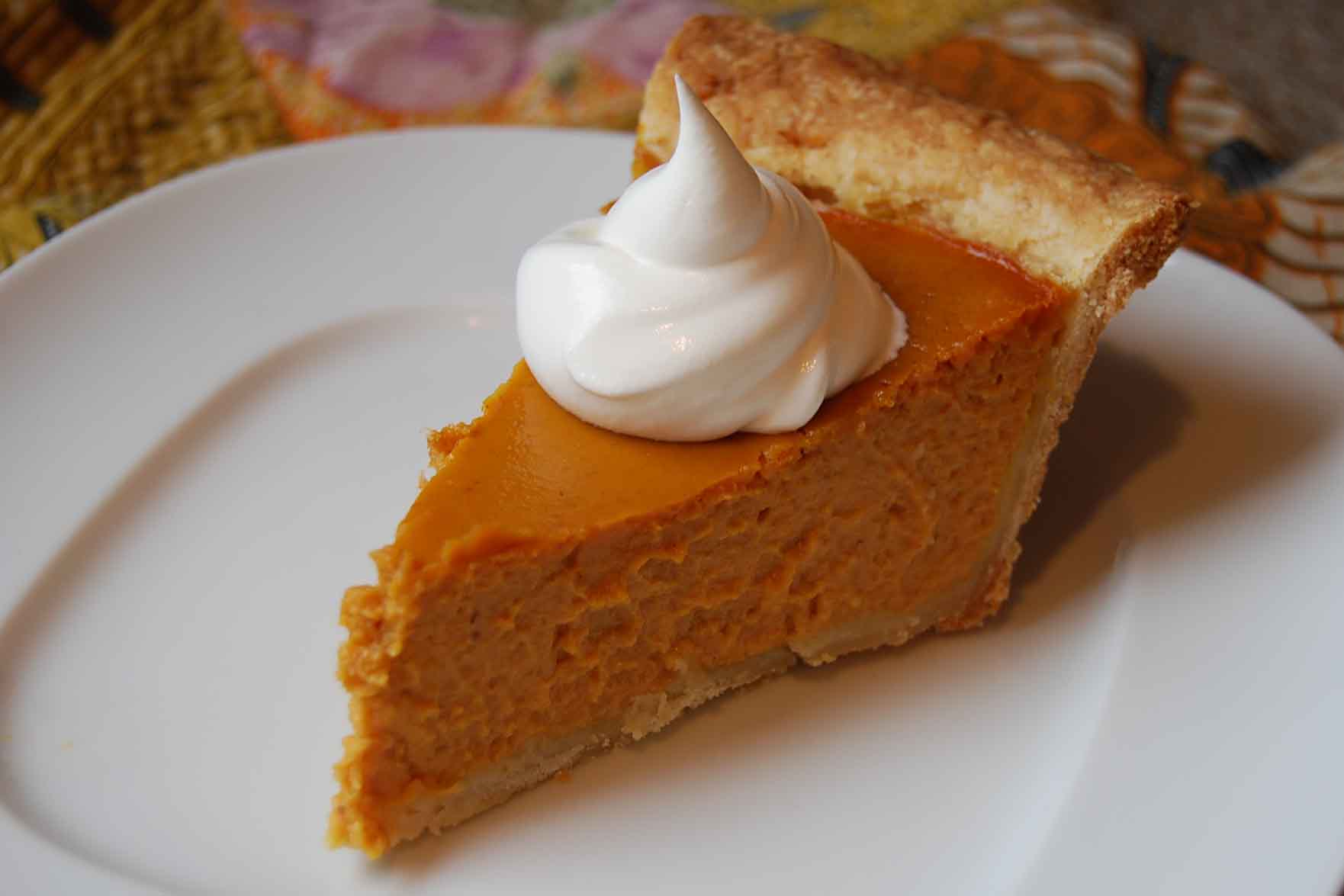
Today in the West people are celebrating “Thanksgiving”. So we are posting a traditional Thanksgiving recipe; Pumpkin Pie (without the eggs). I have been making eggless pumpkin pies for the last 38 years, and have tried many different variations. I use 2 tablespoons of sour cream instead of 2 eggs, and one year I used Philadelphia cream cheese instead of evaporated milk, all with good success.
By the way, this year Thanksgiving falls on Ekadasi (fast from grains and beans), so we will be offering our pumpkin pie with a nut crust.
If you want to do everything yourself, there is the do it yourself recipe for a “homemade” pie crust, pumpkin puree, spicing, sweetened whipped cream, and a pecan nut crust. There is also the more generic recipe with purchased ingredients. (both options follow)
More
18 Sep 2012
by The Hare Krishna Movement
in Health, Practicing Krishna Consciousness at Home, Prasadam, Vegetarian Cooking, Vegetarian Recipies, Vegetarianism
Tags: hare krishna cookbook, hare krishna cooking, health consciousness, Krishna, prabhupada, practicing krishna consciousness at home, Srila Prabhupada, standard devotee diet, vegetarian cooking, vegetarian recipies, vegetarianism

Once when Srila Prabhupada saw what was being served to the devotees, lavishly prepared multi-course lunches, he told the managers that it was too opulent. He said we should eat simply during the week with rice, dhal, chapatis and a little subji and once a week on the Sunday love feasts we could be more lavish. Today with more of us becoming Health Conscious, it is good to remember the very simple devotee diet that was recommended to us so long ago.
Standard Devotee Diet
Srila Prabhupada recommended a standard diet for the devotees, and instructed that all of the temples should follow it every day. That menu follows:
BREAKFAST:
Simple farina cereal with nuts and raisins
Milk (steaming hot), or yogurt in the summertime
Chick peas (raw, soaked overnight)
Ginger root (raw)
Oranges, apples and/or bananas
LUNCH:
Rice
Chapatis
Dal made with freshly ground ginger root and freshly ground spices
Subji made with ghee, freshly ground ginger root and freshly ground spices
BEFORE TAKING REST:
Milk (steaming hot)
Bananas
For a free download of the Hare Krishna Cookbook on pdf More
03 Aug 2012
by The Hare Krishna Movement
in Prasadam, Vegetarian Cooking, Vegetarian Recipies, Vegetarianism
Tags: cookbook manuscript, cooking for Krsna, devotee cookbook, Hare Krishna recipes, Iskcon, Prasadam, prasadam pastimes, Revatinanda dasa, Srila Prabhupada, The Hare Krishna Movement, vegetarian cooking, vegetarian recipes, vegetarianism
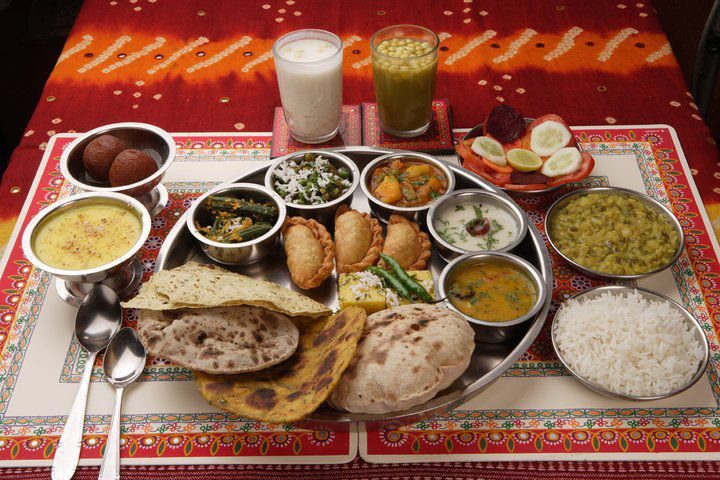
Ran across this fine devotee cookbook on the Sampradaya Sun this morning, and thought we should share it with our readers. The recipes did in fact remind us of the early “love feasts”, and devotee diet in the early days of the Hare Krishna Movement. Very Nice!
1970’s Devotee Cookbook
BY: SUN STAFF
Aug 02, 2012 — CANADA (SUN) —
The following cookbook manuscript, which contains a wonderful collection of vintage Hare Krsna recipes, was handed to us several years ago by a devotee, who’d been carrying an old photocopy of it around for many years. While the manuscript doesn’t bear the author’s name, we’re told that it was likely compiled in the early 1970’s by Revatinanda dasa.
A bit of the text was illegible, but the manuscript is reproduced below. Obviously the cookbook was written while Srila Prabhupada was still physically present. Judging from the language and recipes, our best guess is that it’s circa 1972-73. The recipes will be pleasurably familiar to devotees who remember the wonderful prasadam pastimes in ISKCON temples during the ‘early days’.
Devotee Cookbook
“This is a very limited presentation of recipes for prasadam offerings that I have become practiced in preparing over the last few years. The ingredients and basic techniques used in the preparations are according to parampara tradition. Whether the details are as Srila Prabhupada would have exactly instructed, I do not know, but I have experienced on many occasions that He has been pleased by some of these exact preparations. Also I have experienced that devotees especially, and usually karmies (non-devotees) as well, are very much attracted by my preparations. For these reasons – to increase the attractiveness of our offerings to Sri Sri Radha and Krishna, and to increase the satisfaction of both the devotees and karmies with the prasadam they take to purify their existence – I have prepared this small cook-book. It is simply an offering of one devotee’s experience in the matter of prasadam preparation.
More
Previous Older Entries





